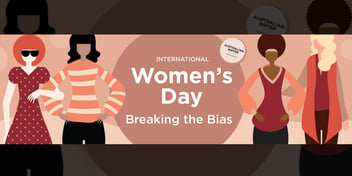Count her in: bolstering representation of women within the water sector

The theme of this year’s International Women’s Day was ‘Count Her In: Invest in Women, Accelerate Progress’, inspiring discussions around the world about how to create pathways to greater economic inclusion for women and girls everywhere.
The Australian Water Association (AWA) and the Water Services Association of Australia (WSAA) hosted a webinar on 12 March to discuss why purposefully making space for women within workplaces is crucial to closing the economic gender gap.
WSAA Customer and Community Manager Evelyn Rodrigues said overcoming bias against women and marginalised groups requires much more than a single day to raise awareness, acknowledge progress and take stock of how far there still is to go.
“This year's International Women’s Day brought a strong focus on the economic inclusion of women. Thankfully, we’ve passed those days when our mothers and aunties had to give up their jobs once they got married, yet women are still not equal,” she said.
“The total remuneration gender pay gap is 19%, which means over the course of a year, the median of what a woman gets paid is more than $18,000 less than what a man is paid. But it's not just about salary.
“An estimated 16% of women have experienced economic abuse from a partner. It’s also estimated that the total economic burden of domestic violence has reached $5 billion a year, just in New South Wales. And the vast majority of that is born by the victim survivor.
“So, what does it mean to provide equal opportunity for women and girls to build capabilities and strengthen our capacity to learn, earn and lead?”
Good with numbers
When it comes to investing in women and accelerating progress in the water sector, KPMG Engineering and Asset Management Partner Tammy Falconer said it’s time to get more purposeful in terms of how to shift the dial on representation.
“As an industry, we're really good at counting and we’ve been counting women, too. We know that about 18% of engineering graduates are women. We also know that female engineers aged between 20-39 exit our industry at a much higher rate than men do,” she said.
“There’s already plenty of counting going on. What I think we need to do better is taking action to change those numbers.
“The water sector is doing much better than the broader engineering workforce in terms of inclusion of women, but there's much more investment that's needed, particularly in mid- and senior-level management. We need to show women entering our workforce that there is a pathway for them.”
2023 AWA Young Water Professional of the Year and Jacobs Water Engineer Chelsea Hayward agrees: “we can't just look at the number of women in an organisation, we also need to look at where those women actually are”.
“As a young woman, it's really powerful to have visible role models in leadership positions so that young women can see career progression,” she said.
Wannon Water Director and Twenty Percent Disability Inclusion Advisory Founder Emma Olivier said it’s crucial for water organisations to look for opportunities to include women at every level of business.
“We know diversity doesn't work in a trickle down or trickle up way, you can't just have leaders at the top and graduates at the bottom. We need to build diversity into every level of the organisation.
“Getting women around the table is one part of it, and there are policies and procedures that can help. But we also have to consider what keeps women at the table, and tackle the systemic barriers that are limiting continued inclusion.”
Inequality is not equal
When working toward equal representation of women in the water sector, ensuring that women from all backgrounds, including marginalised groups, are included in conversations and business decisions is fundamentally important, Olivier said.
“Yes, we are good at counting, but we need to be very aware of who we are counting and who we're not counting. In the water sector, we still have a way to go to close the gender gap, but the representation of women is more mature than many of our other diversity pillars,” she said.
“I have one hand, I have a disability. When we consider gender through an intersectional lens – including disability, cultural backgrounds, including our Indigenous peers, cultural and linguistic diversity and sexual orientation – things begin to get a lot harder.
“The gender gap we speak of becomes a lot bigger. So, what kind of diversity are we including, who are we actually counting?”
Olivier said the water sector must develop more awareness around making space for women that have been given less opportunity.
“Not all inequality is equal. We need everyone to be aware of this. When we see a group of women that hasn't been included, we must call it out. It's much easier for the underrepresented if the rest of the workforce calls it out as well, the voice gets a lot stronger,” she said.
As a young woman in the water sector, Hayward said considering representation of women of all ages is also a key factor in creating inclusive workspaces.
“When it comes to being included in the conversations and decision making, those who are in positions of influence need to make some room. We don't need people to step out, we just need them to shuffle over a little and allow more diverse discussion to be brought in,” she said.
“Young people and other marginalised groups often feel like they’re stuck on the sideline. We need to identify opportunities for lesser heard voices to be subbed in, or look at changing the rules so that we can have more people on the field.
“It definitely makes sense that the teams who are developing solutions are as diverse as the communities that we're creating these solutions for, particularly in the water sector where women are disproportionately impacted by water issues.”
Leaning into diversity
As diversity and inclusion initiatives continue to develop across the sector, Falconer said communicating diversity as a necessary requirement for success will be key – and it starts with acknowledging that space is purposefully being made for representation.
“I'm a diversity hire. I will proudly state that I am a diversity hire. I knew I was a diversity hire when I started my current role because we had conversations about the imperative to increase diversity within our business,” she said.
“We knew that we had a problem, we knew we had to fix it. I'm proud of the fact that my organisation recognised that diversity is a competitive advantage. It is what our clients expect from us and we need to make deliberate actions to achieve it.
“People often throw around the term ‘diversity hire’ as a negative thing, indicating that the hire might not have deserved to be where they are. I don’t subscribe to this view. I believe it’s something to be proud of – it shows that we belong to a workplace that is actively valuing diversity and the skills, expertise and experience we bring to the table.
“One of the things I wish I had realised earlier in my career is that diversity is really all about different ways of thinking. And in a sector that urgently needs new ways of solving problems, being diverse is actually a superpower.”
Olivier agrees, adding that exposure to the stories of diverse people within the workplaces is important in developing inclusive cultures, where everyone feels valued and comfortable turning up to work authentically.
“For most of my career I didn’t speak about having a disability. But, as Tammy said, I realised that my difference was my superpower,” she said.
“But it took me a long time to come to that realisation. I wish I had been more comfortable showing the world that I have a disability earlier on.
“I'm a big believer in storytelling. Sharing our stories with our teams and the people we work with creates a great culture, an inclusive culture, one in which everyone can belong.”


